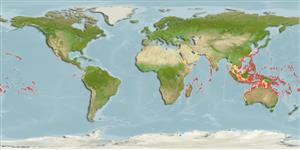Actinopterígios (peces con aletas radiadas) >
Perciformes (Perch-likes) >
Gobiidae (Gobies) > Gobiinae
Etymology: Paragobiodon: Greek, para = the side of + Latin, gobius = gudgeon + Greek,odous =teeth (Ref. 45335).
Medioambiente / Clima / Gama
Ecología
; marino asociado a arrecife; rango de profundidad ? - 47 m (Ref. 86942). Tropical, preferred ?; 30°N - 32°S
Indo-Pacific: Red Sea and East Africa to the Marquesan and Tuamoto islands, north to the Ryukyu Islands, south to Lord Howe Island.
Tamaño / Peso / Age
Maturity: Lm ? range ? - ? cm
Max length : 4.0 cm TL macho / no sexado; (Ref. 4343)
Espinas dorsales (total): 7; Radios blandos dorsales (total): 8-9; Espinas anales 1; Radios blandos anales: 9 - 10. Head reddish-orange; body and fins black (Ref. 1602); characterized further by having ctenoid scales except cycloid on abdomen; scaleless head and nape with bristle-like papillae; complete pelvic fin frenum and basal membrane; longitudinal scale series 23-25; depth of body at level of pelvic fins 3.0-3.2 in SL (Ref. 90102).
Lives among branches of Stylophora coral. Monogamous (Ref. 52884). Usually in small groups, also found in lagoon and seaward reefs in 1-10 m (Ref 90102).
Life cycle and mating behavior
Madurez | Reproducción | Puesta | Huevos | Fecundidad | Larva
Bi-directional sex change has been confirmed for this species (Ref. 103751).
Maugé, L.A., 1986. Gobiidae. p. 358-388. In J. Daget, J.-P. Gosse and D.F.E. Thys van den Audenaerde (eds.) Check-list of the freshwater fishes of Africa (CLOFFA). ISNB, Brussels; MRAC, Tervuren; and ORSTOM, Paris. Vol. 2. (Ref. 4343)
IUCN Red List Status (Ref. 115185)
CITES (Ref. 94142)
Not Evaluated
Threat to humans
Harmless
Human uses
Acuario: Comercial
Más información
ReferenciasAcuiculturaPerfil de acuiculturaRazasGenéticaFrecuencias de alelosheritabilidadEnfermedadesProcesamientoMass conversion
Herramientas
Special reports
Download XML
Fuentes de Internet
